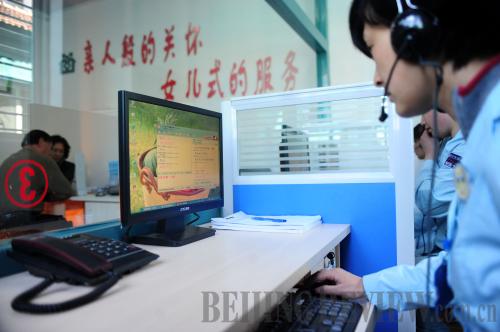 |
|
HEALTH GUARDIAN: Staff at the Liaoshen Community Health Center in Shenyang, northeast China's Liaoning Province, answer questions from patients via an online instant messaging system on April 11 (PAN YULONG) |
Chronic diseases are found to be related to unhealthy lifestyle risk factors such as smoking, obesity and diets high in salt and oil. To some extent these diseases can be prevented and controlled.
"Actually, these conditions are highly preventable and, if people can take simple steps like not smoking, limiting themselves to modest consumption of alcohol, having an active lifestyle and eating a balanced diet, they can keep healthy," said Margaret Chan, Director General of the World Health Organization.
Lifestyle risk factors are prevalent among Chinese population. A 2010 survey on residents above the age of 18 revealed that, more than 80.9 percent of households' salt intake exceeded the recommended daily level of 5 grams, and 83.4 percent of households' oil intake surpassed the recommended daily level of 25 grams.
The survey also showed that only 11.9 percent of Chinese people above 18 exercised often, about 30 percent were overweight, and approximately 10 percent were obese.
In addition, smoking also poses a serious hazard to Chinese people. The country has 350 million smokers and more than 700 million passive smokers. Every year, more than 1 million people die of smoking-related diseases.
"Victory in China's battle against the rising threat of chronic diseases is in the hands of ordinary people," Minister of Health Chen Zhu once said.
The 2012-15 Blueprint on Chronic Disease Prevention and Control sets the targets of reducing lifestyle risk factors such as smoking, lack of exercises, and obesity. It also includes plans to build more green areas and use the media to promote healthy lifestyles.
On August 21-22, the Chinese Center for Disease Control and Prevention hosted a conference to promote healthy lifestyles. Government officials attending the conference, stressed that an active lifestyle is the most cost-efficient measure to prevent chronic diseases.
In Beijing, some new methods have also been used for lifestyle monitoring and coaching.
Liu Lanping, a Beijing resident close to 60, suffers from diabetes and high blood pressure. She has participated in a health self-management program administered by the Desheng Community Health Center in Xicheng District.
Liu carries a beeper-like portable energy monitoring device with her. Community doctors can receive her exercise and diet information via the gadget.
"When I saw doctors in large hospitals, although after prescribing medicine, they told me to exercise and watch my diet, yet they seldom clarify how to exercise and how much to eat," Liu said. Now doctors in the community health center give Liu customized diet and exercise recipes every week.
Before subscribing to the health self-management program, Liu took more than 10 types of drugs daily, and she often felt dizzy. After being in the program for three months when Liu combined medication with exercise and diet control, she became more energetic.
"The health self-management model lets patients of high blood pressure and diabetes learn to put their health in their own hands," said Wang Hanliang, a professor at the National Medical Education Development Center in Beijing.
People used to go to hospital only after they became ill. Now with such technology as the Internet of Things, people can manage their health proactively and have many of their problems solved at the community level, said Liu Guoen, a professor at Guanghua School of Management at Peking University who specializes in health economics.
Managing chronic diseases at the community level cannot only lower total medical expenditures, but also improve patients' quality of life. A study shows that the health self-management program first implemented in Beijing's Xicheng District annually saves an average of 720 yuan ($113.51) for each patients with high blood pressure and 480 yuan ($75.67) each for those with diabetes.
Email us at: wanghairong@bjreview.com | 